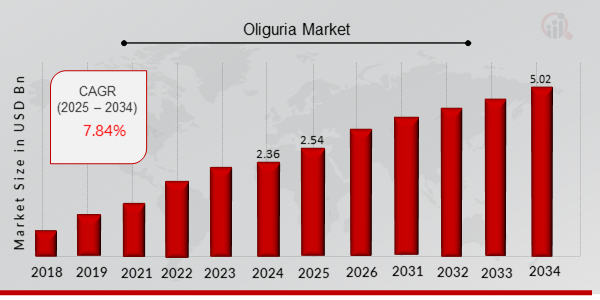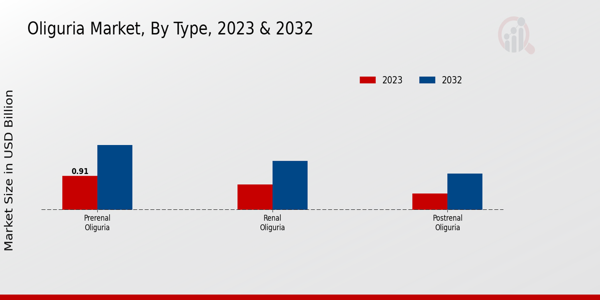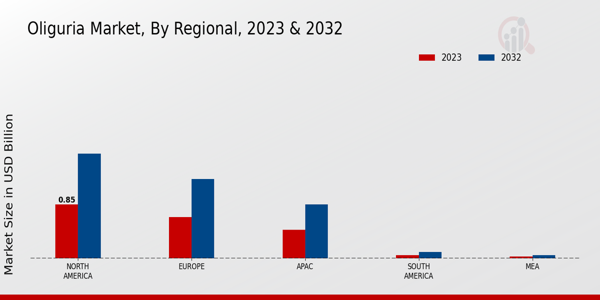Oliguria Market Overview
As per MRFR analysis, the Oliguria Market Size was estimated at 2.36 (USD Billion) in 2024. The Oliguria Market Industry is expected to grow from 2.54 (USD Billion) in 2025 to 5.02 (USD Billion) till 2034, at a CAGR (growth rate) is expected to be around 7.84% during the forecast period (2025 - 2034).
Key Oliguria Market Trends Highlighted
The Oliguria Market is observing immaculate trends owing to increasing number of people with kidney diseases, diabetes, and hypertension, all of which are aspects that lead to oliguria. The increased knowledge on the relevance of early diagnosis and treatment also aid the growth of the market. This increase in knowledge is also increasing the use for complex diagnostic and therapeutic devices. Moreover, the market development is also aided by the growing use of telemedicine and mHealth in patient monitoring and management.
The Oliguria Market further expanding as healthcare providers are looking for new treatments and diagnostic. There is a gap that remains for possible new developments that targets the root cause more efficiently. Also, increasing the healthcare coverage in developing countries is another opportunity in the market. The partnership between pharmaceutical companies and health care facilities will facilitate the research and introduction of new treatment options in the market. The on-going shift towards personalized medicine and patient-centered care will also create opportunities for market growth. Recent practices have shown an increase in focus on the prevention of diseases and modification of the lifestyle to appeal the associated conditions with oliguria.
There is an increased adoption of home-based care, empowering patients to take charge of their health. Changes in healthcare policies and funding can significantly impact the availability of resources for research and treatment, further shaping the market landscape. As the healthcare sector evolves, advancements in biotechnologies and pharmaceuticals will lead to new products enhancing patient outcomes. Overall, the Oliguria Market is positioned for growth, driven by various factors that emphasize patient well-being and innovative solutions.
Fig 1: Oliguria Market Overview

Source: Primary Research, Secondary Research, MRFR Database and Analyst Review
Oliguria Market Drivers
Growing Prevalence of Kidney Disorders
The increasing incidence of kidney disorders is one of the primary drivers of the Oliguria Market Industry. Kidney diseases such as chronic kidney disease (CKD), acute kidney injury (AKI), and other related conditions have become increasingly prevalent in recent years, largely attributed to factors such as diabetes, hypertension, and obesity. As these health issues continue to rise ly, there is a proportional increase in the number of individuals experiencing oliguria, a condition characterized by reduced urine output.This rising trend creates a significant demand for diagnostic services and therapeutic interventions catered to manage and treat patients with oliguria. Healthcare systems worldwide are focusing on advancing their renal care approaches, leading to enhanced investment in renal care products and treatments. The growing disease burden, combined with an aging population that is more susceptible to kidney-related ailments, ensures that the demand for solutions in the Oliguria Market Industry remains strong and resilient.With ongoing research and development efforts aimed at understanding the underlying causes of acute and chronic kidney conditions, the market is poised for further expansion as innovations in treatment protocols and management strategies emerge.
Advancements in Diagnostic Technologies
Advances in diagnostic technologies play a crucial role in propelling the growth of the Oliguria Market Industry. With the integration of innovative technologies such as point-of-care testing, advanced imaging techniques, and other non-invasive diagnostic methods, the identification and monitoring of oliguria have become significantly more efficient. These advancements lead to timely interventions, improving patient outcomes while decreasing healthcare costs associated with late-stage kidney failure.The ability of healthcare professionals to quickly assess the renal function has led to a surge in the demand for sophisticated diagnostic tools, thus fueling the overall market growth.
Increasing Awareness and Education in Kidney Health
There is a growing awareness regarding kidney health and its importance within the broader spectrum of public health. Educational campaigns and initiatives aimed at informing populations about the risk factors and symptoms associated with oliguria and other kidney-related issues have contributed to early diagnosis and preventive care. This heightened understanding influences patients seeking timely medical assistance, further driving the Oliguria Market Industry forward.As awareness continues to spread, the market responds with increased availability of targeted therapeutic options to cater to the needs of affected individuals.
Oliguria Market Segment Insights
Oliguria Market Type Insights
The Oliguria Market revenue has shown significant growth across its various types, especially when examining the segmentation of Prerenal Oliguria, Renal Oliguria, and Postrenal Oliguria. In 2023, the overall market is valued at 2.03 USD Billion, demonstrating a robust demand spurred by increased awareness and treatment options related to renal health. The Prerenal Oliguria segment holds a majority holding within the market, valued at 0.91 USD Billion in 2023, and it is expected to further elevate to 1.73 USD Billion by 2032. This position can be attributed to its frequent occurrence, as it typically arises from factors such as volume depletion, hypotension, or renal perfusion issues, making it a constant focus in clinical settings.The Renal Oliguria segment, valued at 0.68 USD Billion in 2023, is also significant, showcasing a critical need for diagnostic and therapeutic advancements, as this condition denotes direct kidney pathology. As renal function deteriorates, understanding this type becomes vital for effective treatment; it is expected to grow to 1.3 USD Billion by 2032, fueled by increasing incidences of renal diseases. Lastly, Postrenal Oliguria, valued at 0.44 USD Billion in 2023 and projected to reach 0.97 USD Billion by 2032, plays a crucial role despite being the least dominant.This type usually results from urinary obstruction, which emphasizes the importance of early detection in preventing long-term complications. The segmentation within the Oliguria Market data highlights the trends where Prerenal Oliguria remains the forefront due to its high prevalence, while Renal and Postrenal variants support the industry's development and diversification. The market growth can be attributed to evolving treatment options, technological advancements in diagnostics, and a growing awareness regarding kidney health and its importance, creating opportunities for healthcare professionals and organizations to enhance patient care.However, challenges remain, particularly in raising awareness about early symptoms of oliguria and ensuring effective follow-up care, which could impede the overall market growth. The comprehensive understanding of the Oliguria Market Statistics indicates the necessity of targeted strategies to address these issues while capitalizing on the strengths brought by various segments.
Fig 2: Oliguria Market Insights

Source: Primary Research, Secondary Research, MRFR Database and Analyst Review
Oliguria Market Treatment Method Insights
The Oliguria Market, valued at 2.03 billion USD in 2023, is experiencing robust growth, driven by increasing incidences of kidney-related disorders and advancements in treatment methods. Within the Treatment Method segment, various approaches are utilized to manage oliguria effectively. Medication plays a crucial role as the first line of treatment to address the underlying causes. Dialysis remains significant, particularly for patients with severe kidney impairment, providing necessary filtration and homeostasis. Surgery is sometimes indicated to rectify structural abnormalities leading to oliguria, while lifestyle changes are emphasized for long-term management and prevention.These methods collectively contribute to improving patient outcomes. The Oliguria Market revenue reflects a trend towards personalized treatment, and ongoing innovation is expected to enhance the efficacy of existing modalities. Furthermore, the increasing focus on preventive healthcare and patient education offers substantial opportunities for market growth. The integration of advanced technologies in treatment protocols is anticipated to further elevate the standards of care, fostering a significant shift in Oliguria Market data over the next decade.Understanding these aspects of Oliguria Market statistics enables stakeholders to identify trends and align their strategies accordingly.
Oliguria Market Cause Insights
The Oliguria Market, with a projected value of 2.03 USD Billion in 2023, is primarily driven by various causes impacting renal function. Among these, dehydration remains a prominent factor, significantly reducing urine output due to fluid loss. Obstruction presents a critical aspect, where blockages in the urinary tract can severely hinder normal kidney function, showcasing its imperative role in this market. Kidney disease plays a crucial role in the overall landscape, with chronic kidney ailments contributing a notable share to the market dynamics.Circulatory problems are also significant, as inadequate blood flow to the kidneys can exacerbate oliguria, underlining the critical interplay between kidney health and overall circulation. The steady growth of this segment reflects an increasing awareness of these conditions, coupled with advancements in diagnostic techniques. Market trends indicate a rising focus on preventive care and innovative treatment options, contributing to the overall growth. As the Oliguria Market data continues evolving, understanding the causative factors will remain essential for stakeholders in this industry.
Oliguria Market Patient Demographics Insights
The Oliguria Market, valued at 2.03 Billion USD in 2023, reflects a growing interest in renal health across various patient demographics, including Adults, Children, and the Elderly. The Adult population represents a significant portion of the market, driven by rising incidences of chronic conditions that affect kidney function. Meanwhile, Children segment is gaining attention due to an increase in congenital issues and acute kidney injuries, highlighting the need for effective treatment solutions catered to their unique physiological needs.The Elderly demographic is particularly important, as age-related factors predispose this group to oliguria, emphasizing the necessity for specialized care and therapeutic approaches. The market is bolstered by rising health awareness and advancements in diagnostic technologies targeting specific age groups. However, challenges such as accessibility to healthcare and variations in treatment protocols across different regions remain relevant. The Oliguria Market revenue is projected to grow significantly, creating opportunities for innovative solutions tailored to meet the needs of these diverse patient profiles, which will further enhance market statistics and growth potential.
Oliguria Market Regional Insights
The Oliguria Market is projected to reach a significant valuation of 2.03 USD Billion in 2023, with a strong growth trajectory leading to an expected valuation of 4.0 USD Billion by 2032. Among the regional divisions, North America stands out with a valuation of 0.85 USD Billion in 2023, projected to escalate to 1.65 USD Billion by 2032, indicating its majority holding in the market. Europe follows closely, with a valuation of 0.65 USD Billion in 2023 and a projected rise to 1.25 USD Billion by 2032, making it a key player in the Oliguria Market industry.The APAC region, while smaller, shows promising growth from 0.45 USD Billion in 2023 to 0.85 USD Billion in 2032, reflecting increasing healthcare developments. South America and MEA are comparatively lesser in valuation, at 0.05 USD Billion and 0.03 USD Billion in 2023, respectively, showing modest growth potential as they reach 0.1 USD Billion and 0.05 USD Billion by 2032. This varied landscape in regional valuation reveals significant opportunities, driving market growth through increased awareness, healthcare advancements, and patient care initiatives across the regions, with the Oliguria Market data highlighting the necessity for strategic focus on leading areas like North America and Europe due to their dominating presence.
Fig 3: Oliguria Market Regional Insights

Source: Primary Research, Secondary Research, MRFR Database and Analyst Review
Oliguria Market Key Players and Competitive Insights
The Oliguria Market is characterized by a dynamic landscape driven by various factors such as increasing incidences of kidney diseases and rising awareness of renal health. The market is shaped by the presence of multiple key players and their competitive strategies, which include innovation in drug development, strategic partnerships, and a strong emphasis on research and development. The competitive environment encourages companies to focus on enhancing their product offerings while effectively addressing the unmet clinical needs associated with oliguria, a condition characterized by low urine output. As companies strive to capture market share, understanding their strategies and areas of specialization becomes essential for discerning overall market trends and consumer preferences. Merck and Co hold a strong position in the Oliguria Market owing to its extensive portfolio of pharmaceutical solutions and strong commitment to research and development. The company has established a reputation for excellence in producing innovative therapies that address various renal conditions, thereby effectively positioning itself as a leader in this niche segment. Merck and Co leverage its vast resources and expertise to enhance drug efficacy, safety, and patient outcomes, resulting in a robust market presence. The company’s focus on collaboration with healthcare professionals and institutions further strengthens its capabilities in understanding patient needs, leading to the development of tailored therapies that effectively manage oliguria. Additionally, a comprehensive approach to clinical trials and regulatory compliance underscores its commitment to delivering quality healthcare solutions. Pfizer is also a prominent player in the Oliguria Market, showcasing significant strengths primarily through its well-established research infrastructure and a strong pipeline of product candidates aimed at addressing renal-related illnesses. The company's emphasis on scientific innovation and robust clinical trials facilitates the development of advanced therapies that cater to the specific needs of oliguria patients. Pfizer's strong network allows for efficient distribution and accessibility of its products, ensuring that a wide variety of healthcare practitioners and patients can benefit from their offerings. The commitment to health education and awareness initiatives further positions Pfizer as a trusted partner in renal health, fostering collaboration with healthcare systems and enhancing patient engagement. Overall, Pfizer's strategic approach signifies its dedication to improving clinical outcomes for patients suffering from oliguria.
Key Companies in the Oliguria Market Include
-
Merck and Co
-
Pfizer
-
Amgen
-
Astellas Pharma
-
Takeda Pharmaceutical
-
AbbVie
-
Roche
-
GlaxoSmithKline
-
Johnson and Johnson
-
AstraZeneca
-
Bayer
-
Novartis
-
BristolMyers Squibb
-
Gilead Sciences
-
Sanofi
Oliguria Market Industry Developments
Recent developments in the Oliguria Market have been marked by several key trends and activities among major pharmaceutical companies. For instance, Merck and Co., Pfizer, and Amgen continue to invest in innovative treatment solutions for oliguria, enhancing their product pipelines to address unmet medical needs. Astellas Pharma and Takeda Pharmaceutical are also focusing on research and development efforts to create advanced therapeutic options. Recent market evaluations suggest a significant growth trajectory for companies like AbbVie and Roche, driven by increased patient awareness and diagnosis rates. Notable mergers and acquisitions have been seen as industry players like GlaxoSmithKline and Johnson and Johnson seek to strengthen their market positions, fostering collaborations aimed at expanding their therapeutic offerings. AstraZeneca and Bayer are reportedly exploring new strategies to enhance their competitive edge in treating renal conditions associated with oliguria. Meanwhile, Novartis and Bristol-Myers Squibb have been actively engaging in partnerships aimed at encouraging drug innovation, while Gilead Sciences and Sanofi focus on market expansion strategies. Overall, these activities indicate an evolving landscape, with companies strategically aligning their efforts to leverage growth opportunities within the oliguria segment.
Oliguria Market Segmentation Insights
Oliguria Market Type Outlook
- Prerenal Oliguria
- Renal Oliguria
- Postrenal Oliguria
Oliguria Market Treatment Method Outlook
- Medication
- Dialysis
- Surgery
- Lifestyle Changes
Oliguria Market Cause Outlook
- Dehydration
- Obstruction
- Kidney Disease
- Circulatory Problems
Oliguria Market Patient Demographics Outlook
Oliguria Market Regional Outlook
- North America
- Europe
- South America
- Asia Pacific
- Middle East and Africa
| Report Attribute/Metric |
Details |
|
Market Size 2024
|
2.36 (USD Billion)
|
|
Market Size 2025
|
2.54 (USD Billion)
|
|
Market Size 2034
|
5.02 (USD Billion)
|
|
Compound Annual Growth Rate (CAGR)
|
7.84 % (2025 - 2034)
|
|
Report Coverage
|
Revenue Forecast, Competitive Landscape, Growth Factors, and Trends
|
|
Base Year
|
2024
|
|
Market Forecast Period
|
2025 - 2034
|
|
Historical Data
|
2020 - 2024
|
| Market Forecast Units |
USD Billion |
| Key Companies Profiled |
Merck and Co, Pfizer, Amgen, Astellas Pharma, Takeda Pharmaceutical, AbbVie, Roche, GlaxoSmithKline, Johnson and Johnson, AstraZeneca, Bayer, Novartis, BristolMyers Squibb, Gilead Sciences, Sanofi |
| Segments Covered |
Type, Treatment Method, Cause, Patient Demographics, Regional |
| Key Market Opportunities |
Rising prevalence of kidney disorders, Advancements in diagnostic technologies, Increased healthcare expenditure, Growing geriatric population, Enhanced patient awareness and education |
| Key Market Dynamics |
Rising incidence of kidney diseases, Increasing awareness and diagnosis, Advancements in renal treatment options, Growth in healthcare expenditure, Aging population and comorbidities |
| Countries Covered |
North America, Europe, APAC, South America, MEA |
Frequently Asked Questions (FAQ) :
The Oliguria Market is expected to be valued at 4.0 USD Billion in 2034.
The expected CAGR for the Oliguria Market from 2025 to 2034 is 7.84%.
North America is anticipated to dominate the Oliguria Market with a value of 1.65 USD Billion by 2034.
Prerenal Oliguria is expected to reach a market size of 1.73 USD Billion in 2034.
Key players in the Oliguria Market include Merck and Co, Pfizer, Amgen, and Roche among others.
Renal Oliguria is projected to have a market value of 1.3 USD Billion in 2034.
The market size for Postrenal Oliguria is expected to be 0.97 USD Billion in 2034.
The Oliguria Market in Europe is expected to grow from 0.65 USD Billion in 2023 to 1.25 USD Billion in 2034.
The APAC region's Oliguria Market is projected to grow to 0.85 USD Billion by 2034.
Challenges could arise from increasing competition and regulatory hurdles in the healthcare sector impacting growth.

















